NCERT Solutions for Class 10 Maths Chapter 10 Circles
Circles NCERT Solutions – Class 10 Maths
Exercise 10.1 : Solutions of Questions on Page Number : 204
Q1 :How many tangents can a circle have?
Answer :
A circle can have infinite tangents.
Q2 : Fill in the blanks:
(i) A tangent to a circle intersects it in _______ point (s).
(ii) A line intersecting a circle in two points is called a __________.
(iii) A circle can have __________ parallel tangents at the most.
(iv) The common point of a tangent to a circle and the circle is called ____.
Answer :
(i) One
(ii) Secant
(iii) Two
(iv) Point of contact
Q3 : A tangent PQ at a point P of a circle of radius 5 cm meets a line through the centre O at a point Q so that OQ = 12 cm. Length PQ is :
(A) 12 cm. (B) 13 cm (C) 8.5 cm (D) cm
Answer :
We know that the line drawn from the centre of the circle to the tangent is perpendicular to the tangent.
![]() OP
OP![]() PQ
PQ
By applying Pythagoras theorem in ΔOPQ,

OP2 + PQ2 = OQ2
52 + PQ2 =122
PQ2 =144 – 25
PQ = ![]() cm.
cm.
Hence, the correct answer is (D).
Q4 : Draw a circle and two lines parallel to a given line such that one is a tangent and the other, a secant to the circle.
Answer :
It can be observed that AB and CD are two parallel lines. Line AB is intersecting the circle at exactly two points, P and Q. Therefore, line AB is the secant of this circle. Since line CD is intersecting the circle at exactly one point, R, line CD is the tangent to the circle.
Exercise 10.2 : Solutions of Questions on Page Number : 213
Q1 : From a point Q, the length of the tangent to a circle is 24 cm and the distance of Q from the centre is 25 cm. The radius of the circle is
(A) 7 cm (B) 12 cm
(C) 15 cm (D) 24.5 cm
Answer :
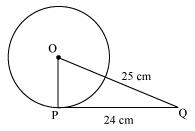
Let O be the centre of the circle.
Given that,
OQ = 25cm and PQ = 24 cm
As the radius is perpendicular to the tangent at the point of contact,
Therefore, OP ⊥ PQ
Applying Pythagoras theorem in ΔOPQ, we obtain
OP2 + PQ2 = OQ2
OP2 + 242 = 252
OP2 = 625 – 576
OP2 = 49
OP = 7
Therefore, the radius of the circle is 7 cm.
Hence, alternative (A) is correct.
Q2 : In the given figure, if TP and TQ are the two tangents to a circle with centre O so that ∠POQ = 110, then ∠PTQ is equal to
(A) 60° (B) 70°
(C) 80° (D) 90°

Answer :
It is given that TP and TQ are tangents.
Therefore, radius drawn to these tangents will be perpendicular to the tangents.
Thus, OP ⊥ TP and OQ ⊥ TQ
∠OPT = 90 º
∠OQT = 90 º
In quadrilateral POQT,
Sum of all interior angles = 360°
∠OPT + ∠POQ +∠OQT + ∠PTQ = 360°
⇒ 90+ 110 º + 90 +PTQ = 360°
⇒ PTQ = 70°
Hence, alternative (B) is correct.
Q3 : If tangents PA and PB from a point P to a circle with centre O are inclined to each other an angle of 80, then ∠POA is equal to
(A) 50° (B) 60°
(C) 70° (D) 80°
Answer :
It is given that PA and PB are tangents.
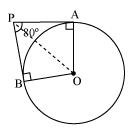
Therefore, the radius drawn to these tangents will be perpendicular to the tangents.
Thus, OA ⊥ PA and OB ⊥ PB
∠OBP = 90 º
∠OAP = 90 º
In AOBP,
Sum of all interior angles = 360°
∠OAP + ∠APB +∠PBO + ∠BOA = 360°
90° + 80° +90 º +BOA = 360°
∠BOA = 100°
In ΔOPB and ΔOPA,
AP = BP (Tangents from a point)
OA = OB (Radii of the circle)
OP = OP (Common side)
Therefore, ΔOPB ≅ ΔOPA (SSS congruence criterion)
A ↔ B, P ↔ P, O ↔ O
And thus, ∠POB = ∠POA
![]()
Hence, alternative (A) is correct.
Q4 : Prove that the tangents drawn at the ends of a diameter of a circle are parallel.
Answer :
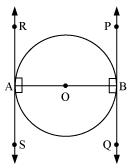
Let AB be a diameter of the circle. Two tangents PQ and RS are drawn at points A and B respectively.
Radius drawn to these tangents will be perpendicular to the tangents.
Thus, OA ⊥ RS and OB ⊥ PQ
∠ OAR = 90º
∠ OAS = 90º
∠ OBP = 90º
∠ OBQ = 90º
It can be observed that
∠ OAR = ∠ OBQ (Alternate interior angles)
∠ OAS = ∠ OBP (Alternate interior angles)
Since alternate interior angles are equal, lines PQ and RS will be parallel.
Q5 : Prove that the perpendicular at the point of contact to the tangent to a circle passes through the centre.
Answer :
Let us consider a circle with centre O. Let AB be a tangent which touches the circle at P.
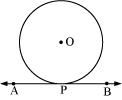
We have to prove that the line perpendicular to AB at P passes through centre O. We shall prove this by contradiction method.
Let us assume that the perpendicular to AB at P does not pass through centre O. Let it pass through another point O’. Join OP and O’P.

As perpendicular to AB at P passes through O’, therefore,
∠ O’PB = 90° … (1)
O is the centre of the circle and P is the point of contact. We know the line joining the centre and the point of contact to the tangent of the circle are perpendicular to each other.
∴ ∠ OPB = 90° … (2)
Comparing equations (1) and (2), we obtain
∠ O’PB = ∠ OPB … (3)
From the figure, it can be observed that,
∠ O’PB < ∠ OPB … (4)
Therefore, ∠ O’PB = ∠ OPB is not possible. It is only possible, when the line O’P coincides with OP.
Therefore, the perpendicular to AB through P passes through centre O.
Q6 : The length of a tangent from a point A at distance 5 cm from the centre of the circle is 4 cm. Find the radius of the circle.
Answer :
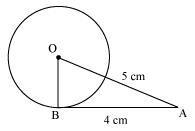
Let us consider a circle centered at point O.
AB is a tangent drawn on this circle from point A.
Given that,
OA = 5cm and AB = 4 cm
In ΔABO,
OB ⊥ AB (Radius ⊥ tangent at the point of contact)
Applying Pythagoras theorem in ΔABO, we obtain
AB2 + BO2 = OA2
42 + BO2 = 52
16 + BO2 = 25
BO2 = 9
BO = 3
Hence, the radius of the circle is 3 cm.
Q7 : Two concentric circles are of radii 5 cm and 3 cm. Find the length of the chord of the larger circle which touches the smaller circle.
Answer :
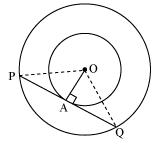
Let the two concentric circles be centered at point O. And let PQ be the chord of the larger circle which touches the smaller circle at point A. Therefore, PQ is tangent to the smaller circle.
OA ⊥ PQ (As OA is the radius of the circle)
Applying Pythagoras theorem in ΔOAP, we obtain
OA2 + AP2 = OP2
32 + AP2 = 52
9 + AP2 = 25
AP2 = 16
AP = 4
In ΔOPQ,
Since OA ⊥ PQ,
AP = AQ (Perpendicular from the center of the circle bisects the chord)
PQ = 2AP = 2 × 4 = 8
Therefore, the length of the chord of the larger circle is 8 cm.
Q8 : A quadrilateral ABCD is drawn to circumscribe a circle (see given figure) Prove that AB + CD = AD + BC

Answer :
It can be observed that
DR = DS (Tangents on the circle from point D) … (1)
CR = CQ (Tangents on the circle from point C) … (2)
BP = BQ (Tangents on the circle from point B) … (3)
AP = AS (Tangents on the circle from point A) … (4)
Adding all these equations, we obtain
DR + CR + BP + AP = DS + CQ + BQ + AS
(DR + CR) + (BP + AP) = (DS + AS) + (CQ + BQ)
CD + AB = AD + BC
Q9 : In the given figure, XY and X’Y’ are two parallel tangents to a circle with centre O and another tangent AB with point of contact C intersecting XY at A and X’Y’ at B. Prove that ∠AOB=90°.

Answer :
Let us join point O to C.
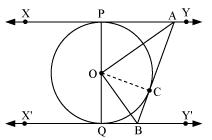
In ΔOPA and ΔOCA,
OP = OC (Radii of the same circle)
AP = AC (Tangents from point A)
AO = AO (Common side)
ΔOPA ΔOCA (SSS congruence criterion)
Therefore, P ↔ C, A ↔ A, O ↔ O
∠POA = ∠COA … (i)
Similarly, ΔOQB ![]() ΔOCB
ΔOCB
∠QOB = ∠COB … (ii)
Since POQ is a diameter of the circle, it is a straight line.
Therefore, ∠POA + ∠COA + ∠COB + ∠QOB = 180 º
From equations (i) and (ii), it can be observed that
2∠COA + 2 ∠COB = 180 º
∠COA + ∠COB = 90 º
∠AOB = 90°
Q10 : Prove that the angle between the two tangents drawn from an external point to a circle is supplementary to the angle subtended by the line-segment joining the points of contact at the centre.
Answer :

Let us consider a circle centered at point O. Let P be an external point from which two tangents PA and PB are drawn to the circle which are touching the circle at point A and B respectively and AB is the line segment, joining point of contacts A and B together such that it subtends ∠ AOB at center O of the circle.
It can be observed that
OA (radius) ⊥ PA (tangent)
Therefore, ∠ OAP = 90°
Similarly, OB (radius) ⊥ PB (tangent)
∠ OBP = 90°
In quadrilateral OAPB,
Sum of all interior angles = 360º
∠ OAP +∠ APB+∠ PBO +∠ BOA = 360º
90º + ∠ APB + 90º + ∠ BOA = 360º
∠ APB + ∠ BOA = 180º
Hence, it can be observed that the angle between the two tangents drawn from an external point to a circle is supplementary to the angle subtended by the line-segment joining the points of contact at the centre.
Q11 : Prove that the parallelogram circumscribing a circle is a rhombus.
Answer :
Since ABCD is a parallelogram,
AB = CD …(1)
BC = AD …(2)

It can be observed that
DR = DS (Tangents on the circle from point D)
CR = CQ (Tangents on the circle from point C)
BP = BQ (Tangents on the circle from point B)
AP = AS (Tangents on the circle from point A)
Adding all these equations, we obtain
DR + CR + BP + AP = DS + CQ + BQ + AS
(DR + CR) + (BP + AP) = (DS + AS) + (CQ + BQ)
CD + AB = AD + BC
On putting the values of equations (1) and (2) in this equation, we obtain
2AB = 2BC
AB = BC …(3)
Comparing equations (1), (2), and (3), we obtain
AB = BC = CD = DA
Hence, ABCD is a rhombus.
Q12 : A triangle ABC is drawn to circumscribe a circle of radius 4 cm such that the segments BD and DC into which BC is divided by the point of contact D are of lengths 8 cm and 6 cm respectively (see given figure). Find the sides AB and AC.
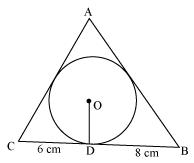
Answer :

Let the given circle touch the sides AB and AC of the triangle at point E and F respectively and the length of the line segment AF be x.
In ABC,
CF = CD = 6cm (Tangents on the circle from point C)
BE = BD = 8cm (Tangents on the circle from point B)
AE = AF = x (Tangents on the circle from point A)
AB = AE + EB = x + 8
BC = BD + DC = 8 + 6 = 14
CA = CF + FA = 6 + x
2s = AB + BC + CA
= x + 8 + 14 + 6 + x
= 28 + 2x
s = 14 + x
Area of ΔOBC =
Area of ΔOCA =![]()
Area of ΔOAB =![]()
Area of ΔABC = Area of ΔOBC + Area of ΔOCA + Area of ΔOAB

Either x+14 = 0 or x – 7 =0
Therefore, x = – 14and 7
However, x = – 14 is not possible as the length of the sides will be negative.
Therefore, x = 7
Hence, AB = x + 8 = 7 + 8 = 15 cm
CA = 6 + x = 6 + 7 = 13 cm
Q13 : Prove that opposite sides of a quadrilateral circumscribing a circle subtend supplementary angles at the centre of the circle.
Answer :

Let ABCD be a quadrilateral circumscribing a circle centered at O such that it touches the circle at point P, Q, R, S. Let us join the vertices of the quadrilateral ABCD to the center of the circle.
Consider ΔOAP and ΔOAS,
AP = AS (Tangents from the same point)
OP = OS (Radii of the same circle)
OA = OA (Common side)
ΔOAP ≅ ΔOAS (SSS congruence criterion)
Therefore, A â” ” A, P â” ” S, O â” ” O
And thus, ∠ POA = ∠ AOS
∠ 1 = ∠ 8
Similarly,
∠ 2 = ∠ 3
∠ 4 = ∠ 5
∠ 6 = ∠ 7
∠ 1 + ∠ 2 + ∠ 3 + ∠ 4 + ∠ 5 + ∠ 6 + ∠ 7 + ∠ 8 = 360º
(∠ 1 + ∠ 8) + (∠ 2 + ∠ 3) + (∠ 4 + ∠ 5) + (∠ 6 + ∠ 7) = 360º
2∠ 1 + 2∠ 2 + 2∠ 5 + 2∠ 6 = 360º
2(∠ 1 + ∠ 2) + 2(∠ 5 + ∠ 6) = 360º
(∠ 1 + ∠ 2) + (∠ 5 + ∠ 6) = 180º
∠ AOB + ∠ COD = 180º
Similarly, we can prove that ∠ BOC + ∠ DOA = 180º
Hence, opposite sides of a quadrilateral circumscribing a circle subtend supplementary angles at the centre of the circle.
NCERT Solutions for Class 10 Maths All Chapters
- Chapter 1 – Real Numbers
- Chapter 2 – Polynomials
- Chapter 3 – Pair of Linear Equations in Two Variables
- Chapter 4 – Quadratic Equations
- Chapter 5 – Arithmetic Progressions
- Chapter 6 – Triangles
- Chapter 7 – Coordinate Geometry
- Chapter 8 – Introduction to Trigonometry
- Chapter 9 – Some Applications of Trigonometry
- Chapter 10 – Circles
- Chapter 11 – Constructions
- Chapter 12 – Areas Related to Circles
- Chapter 13 – Surface Areas and Volumes
- Chapter 14 – Statistics
- Chapter 15 – Probability